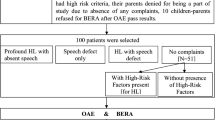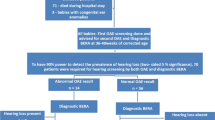Abstract
Objective
This study was designed to evaluate Transient Evoked Oto-acoustic Emission (TEOAE) as screening modality for hearing impairment in neonates. Brainstem Evoked Response Auditometry (BERA) was used as gold standard diagnostic tool in this study. The factors affecting the specificity of TEOAE were also studied.
Methods
The study group of 200 randomly selected neonates was subjected to TEOAE and BERA (400 ears). Oto-endoscopy was done in all TEOAE failures and a repeat test was done after suction cleaning of blocked external auditory canal (EAC).
Results
Otoscopic evaluation of all 52 TEOAE failures was done. EAC obstruction was noticed in 31 ears and 4 ears showed collapsible EAC. TEOAE was repeated after suction cleaning of the obstructed EAC and using long probe tips for collapsible EAC. This improved the Pass rate of TEOAE from 87% to 92%. EAC obstruction and collapsible EAC were the two factors identified in this study that significantly affected the specificity of TEOAE as a screening test. Pass rate of TEOAE in <48 hrs age group was found to be 55.5%, which was nearly half of over-all pass rate. This was because of high prevalence of obstructed EAC in this age group. TEOAE was found to be a rapid screening tool as average time taken for BERA was 35 min/neonate and for TEOAE was 17.4 min/neonate. Acceptability of TEOAE was found to be higher as compared to BERA.
Conclusions
TEOAE is a simple and rapid test with relatively higher acceptability. But, the low sensitivity and specificity are the main shortcomings that take away from TEOAE, the status of independent screening modality for hearing impairment in neonates. TEOAE cannot completely replace BERA as screening modality for hearing impairment in neonates, however can complement it.
Similar content being viewed by others
References
Feinmesser M, Tell L, Levi H. Follow up of 40,000 infants screened for hearing defect. Audiology 1982; 21: 197–203.
Kankkune A. Preschool children with impaired hearing in Goteborg. Acta Otolaryngol Suppl 1982: 391.
Martin JAM. Aetiological factors relating to childhood deafness in the European Community. Audiology 1982; 21: 149–158.
Thringer K. Kankunen A. Liden G. Niklasson A. Perinatal risk factors in the etiology of hearing loss in preschool children. Dev Med Child. Neurol 1984; 26: 799–807.
McPherson B. Holborow CA. A study of deafness in West Africa: the Gambian hearing health project. Int J Pediatr Otorhinolaryngol 1985; 10: 115–135.
Christine Yoshinaga-Itano. Allison L. Sedey. Diane K. Coulter. Albert L. Mehl. Language of Early-and Later-identified Children With Hearing Loss. Pediatrics 1998; 102: 1161–1171.
Joint Committee on Infant Hearing: 1990 position statement. American Speech-Language-Hearing Association 1991 Suppl. 5; 33: 3–6.
Krumholtz A. Felix JK. Gold Steins PJ. McKenzie E. Maturation of brain stem audiometry evoked potential in premature infants. Electroenceph Clin Neurophysiol 1985; 62: 124–134.
Lenhardt ML. McArtor R. Bryant B. Effect of neonatal hyperbilirubinemia on the brainstem electric response. J Paed 1984; 104:281–284.
Nakamura II. Takada S. Shimbuku R. Matsuo M. Hirokuni N. Auditory nerve and brainstem responses in newborn infants with hyperbilirubinaemia. Pediatrics 1985; 75: 703–708.
Perlman M. Fainmesser P. Sohmer H. Tamari H. Yohana W. Pevsmer B. Auditory nerve brainstem evoked responses in hyperbilirubinemic neonates. Paediatrics 1983; 72: 658–664.
Davis H. The cochlear amplifier. Hearing Research 1983; 9: 79–90.
Vohr BR. White KR. Maxon AB. Johnson MJ. Factors affecting the interpretation of transient evoked otoacoustic emissions in neonatal hearing screening. Semin Hear 1993; 14: 53–72.
Chang KW. Vohr BR. Nortan SJ. Lekas MD. External and middle ear status related to evoked otoacoustic emission in neonates. Arch Otolaryngol Head Neck Surg 1993; 119: 276–282.
Doyle KJ. Burggraaff B. Fujikawa S. Kim J. Newborn hearing screening by otoacoustic emissions and automated auditory brainstem response. Int J Pediatr Otorhinolaryngol 1997; 41: 111–119.
Thornton ARD. Kimm L. Kennedy CR. Cafarelli Dees D. External and middle ear factor affecting evoked oto-acoustic emissions. Br J Audiol 1993; 27: 319–27.
Kemp DT. Ryan S. Bray P. A guide to effective use of Otoacoustic Emissions. Ear and Hearing 1990; 11: 93–105.
Stevens JC. Webb HD. Smith MF. Buffin JT. The effects of stimulus level on click evoked oto-acoustic emissions and brainstem responses in neonates under intensive care. Br J Audiol 1990; 24: 293–300.
National Institute of Health Consensus Statement: Early identification of hearing impairment in infants and young children. NIH consensus statement. National Institute of Health, Bethesda Md. 1993; 11: 1–15.
Alberti PW. Hyde ML. Riko K. Corbin H. Fitzhardinge PM. Issues in early identification of hearing loss. Laryngoscope 1985; 95: 373–381.
Author information
Authors and Affiliations
Rights and permissions
About this article
Cite this article
Dhawan, R., Mathur, N.N. Comparative evaluation of Transient Evoked Oto-acoustic Emissions and Brainstem Evoked Response Audiometry as screening modality for hearing impairment in neonates. Indian J Otolaryngol Head Neck Surg 59, 15–18 (2007). https://doi.org/10.1007/s12070-007-0004-7
Published:
Issue Date:
DOI: https://doi.org/10.1007/s12070-007-0004-7




